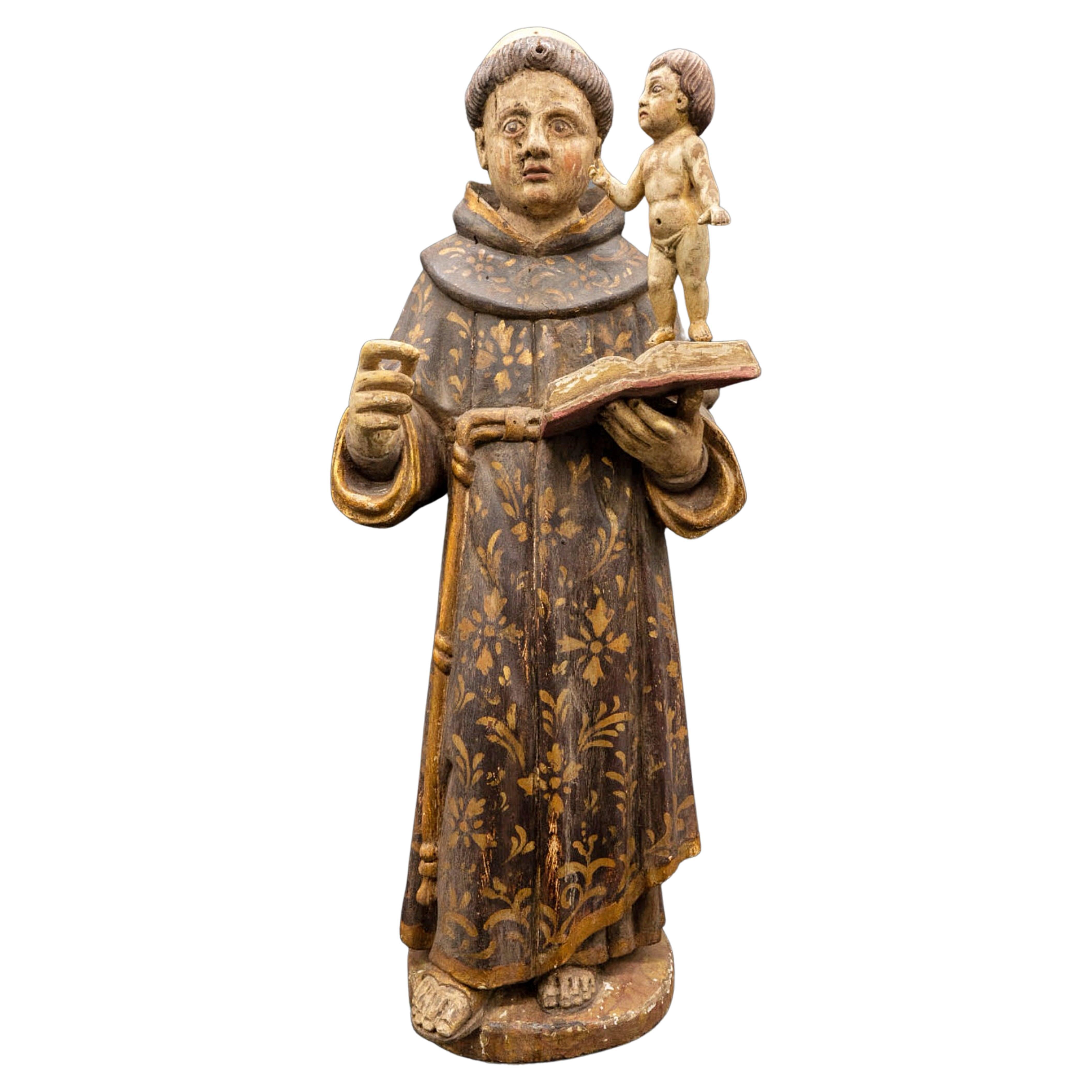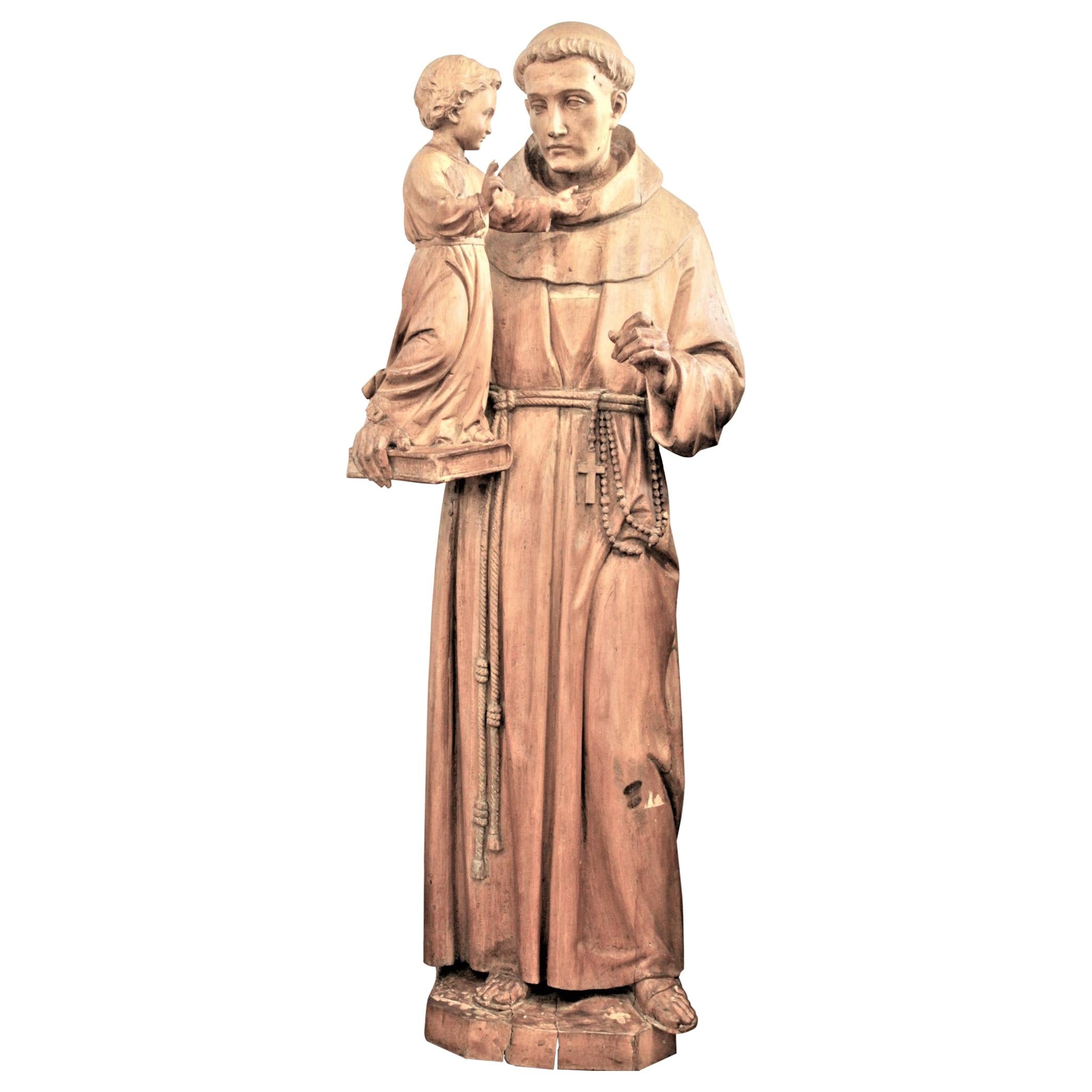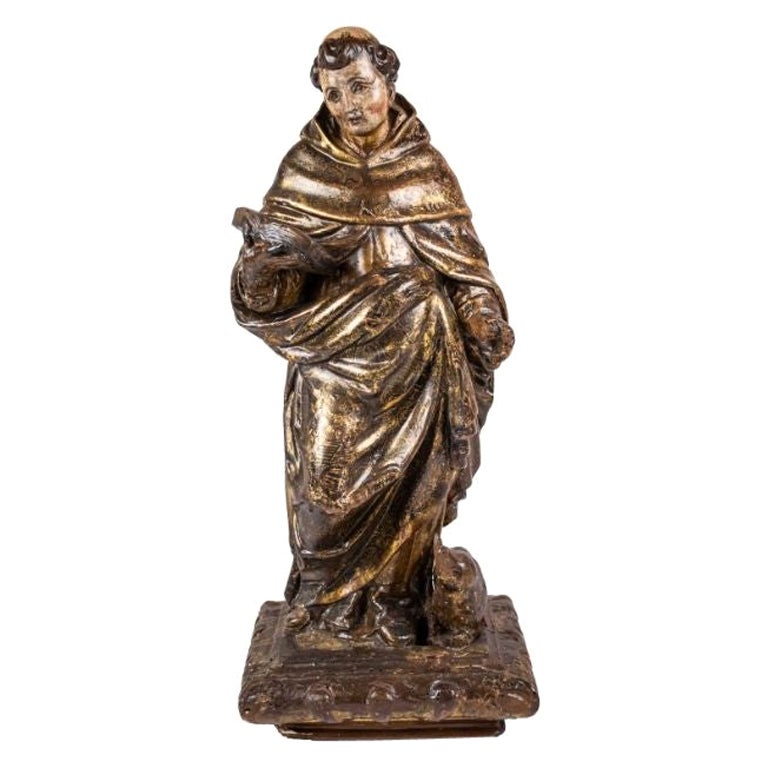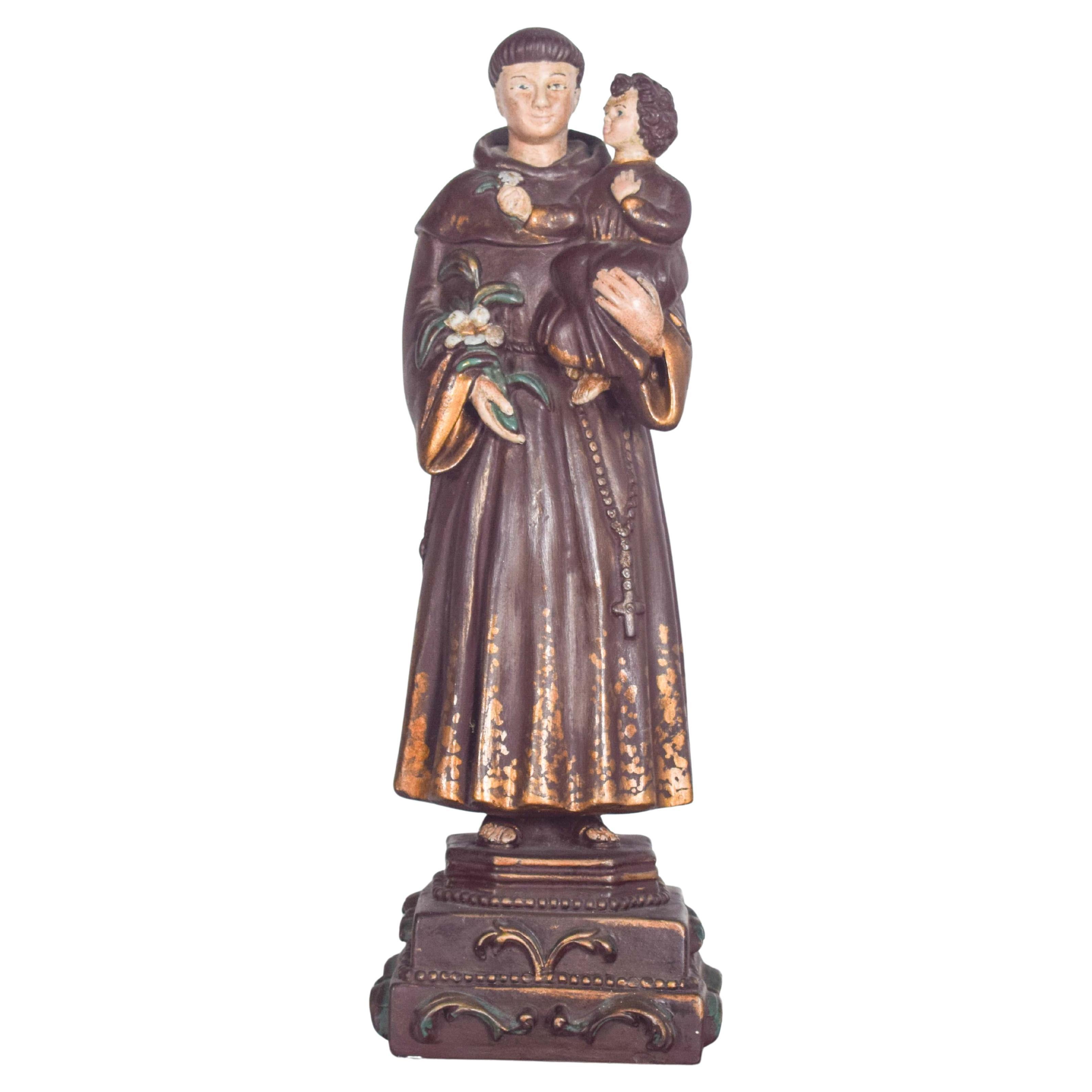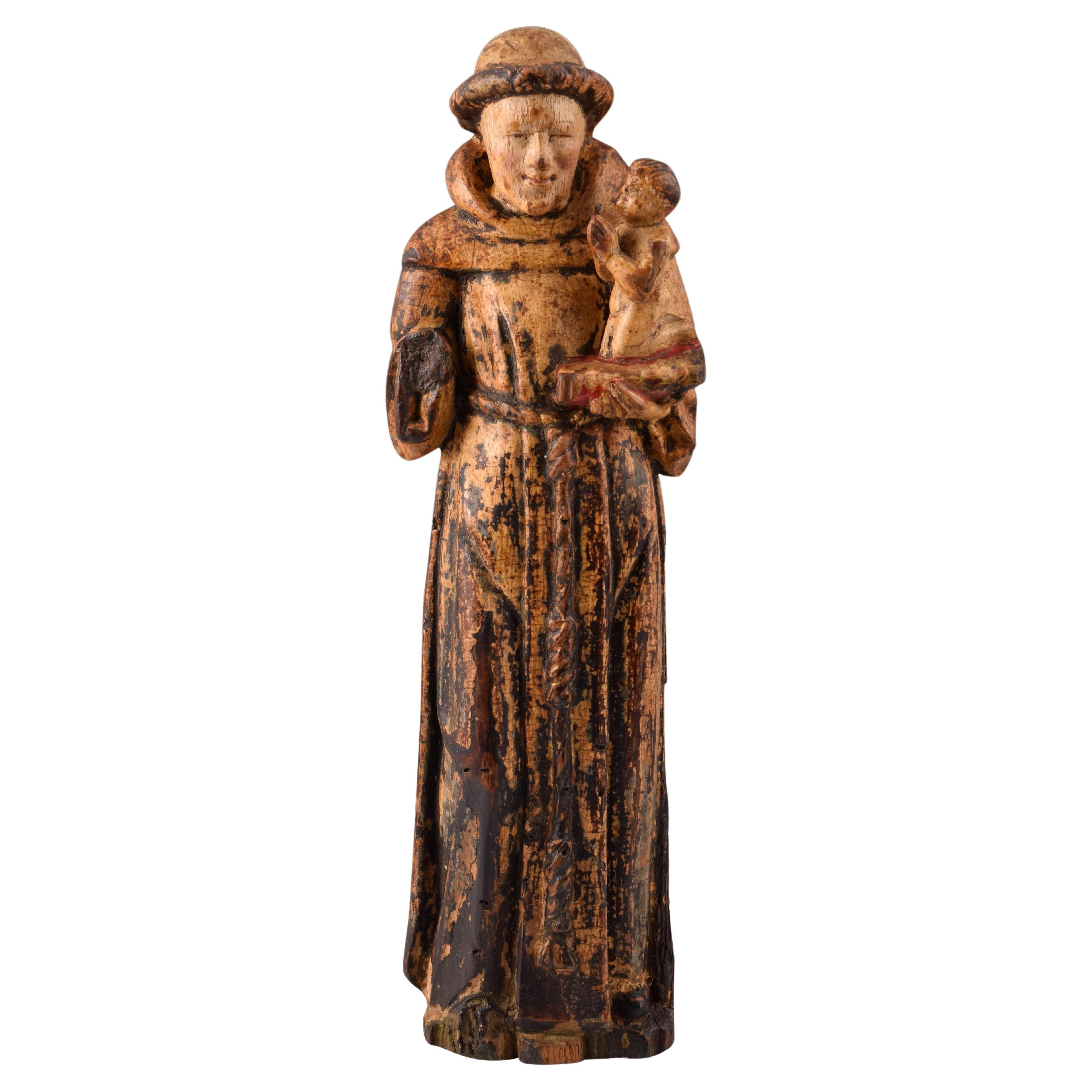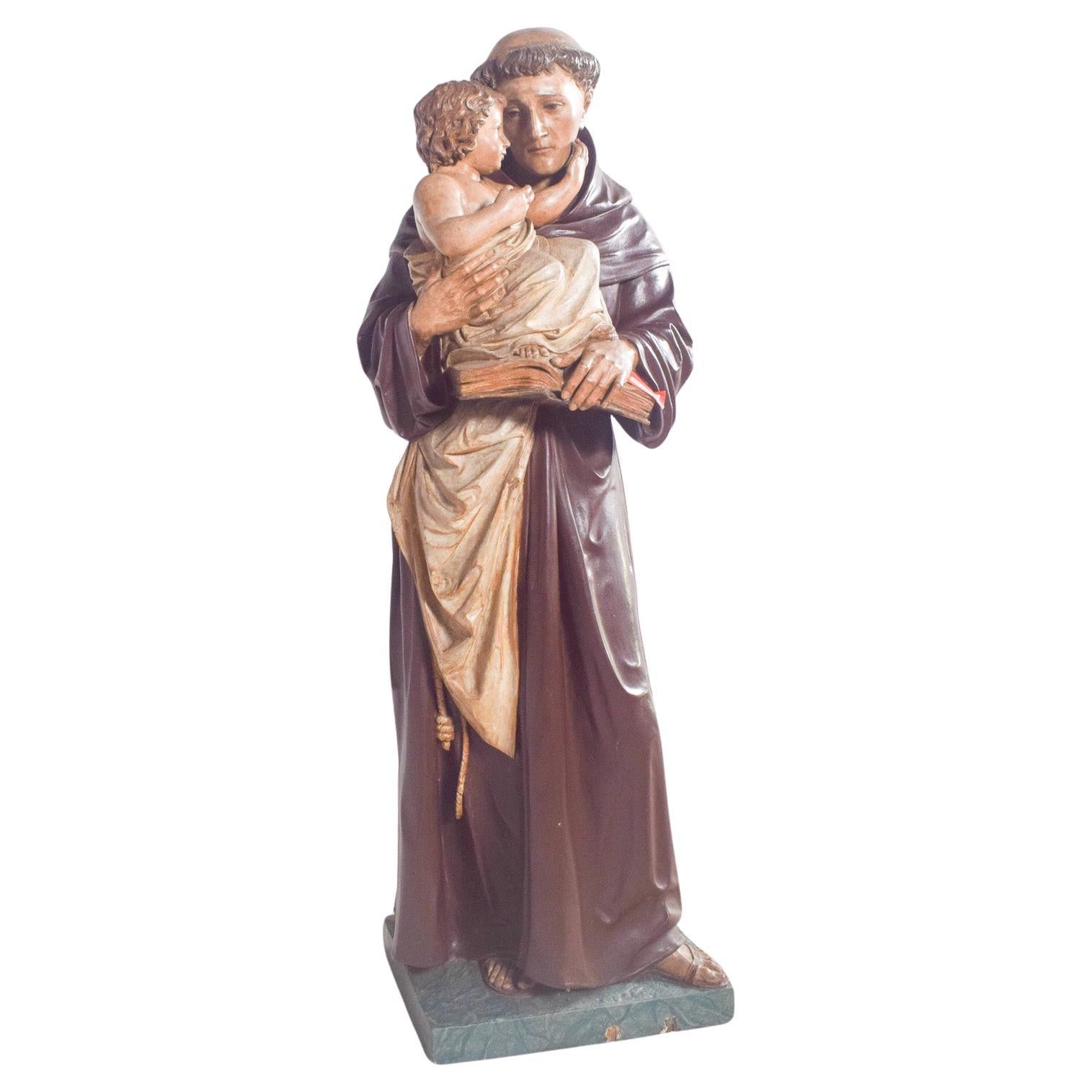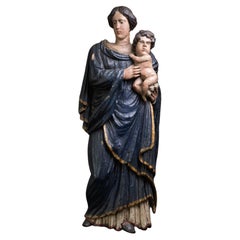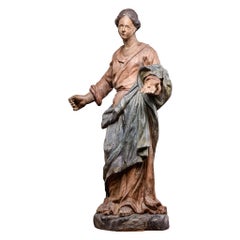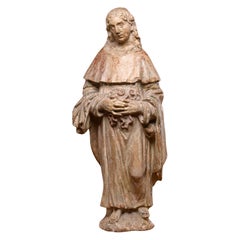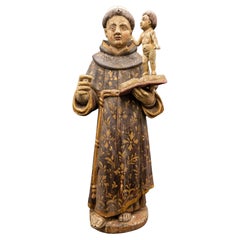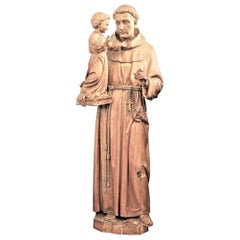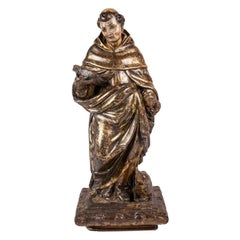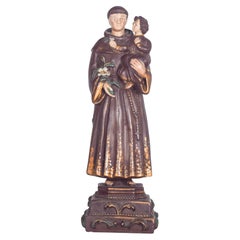Items Similar to Late 17th Century Italian School Wooden Sculpture of Saint Anthony and the Child
Want more images or videos?
Request additional images or videos from the seller
1 of 18
Late 17th Century Italian School Wooden Sculpture of Saint Anthony and the Child
$10,723.39
£7,981.38
€8,950
CA$14,688.36
A$16,336.66
CHF 8,530.50
MX$198,799.76
NOK 108,947.45
SEK 102,173.49
DKK 68,133.23
Shipping
Retrieving quote...The 1stDibs Promise:
Authenticity Guarantee,
Money-Back Guarantee,
24-Hour Cancellation
About the Item
According to the legends, there are two Saint Anthony’s, they can easily be distinguished by their hair. This one is known as Saint Anthony of Padua, he is recognizable by his hair, which is a clerical tonsure. It is practice of cutting or shaving some of all the hair on the scalp as a sign of religious devotion. Saint Anthony was born in 1232 in Lisbon, Portugal. He was a Portuguese Catholic priest and friar of the Franciscan Order. Known by his contemporaries for his powerful preaching, expert knowledge of scripture and undying love and devotion to the poor and the sick, he was one of the most quickly canonized saints in church history. Saint Anthony of Padua is also known as patron saint of lost things.
The wooden figure is standing on a wooden block and is holding the Child in his left hand. The wood is carved with much detail for the fold in Saint Anthony’s robes and the hair. The child is seated on an open book and is holding a round object in his hand. The back shows the most signs of age-related damage and has a small iron bar to secure the statue against the wall. The sculpture is in an overall good condition and shows some age cracks in the front and the back.
- Dimensions:Height: 57.09 in (145 cm)Width: 27.96 in (71 cm)Depth: 15.75 in (40 cm)
- Materials and Techniques:
- Place of Origin:
- Period:Early 17th Century
- Date of Manufacture:Unknown
- Condition:Wear consistent with age and use. Minor losses.
- Seller Location:Leuven , BE
- Reference Number:Seller: 16671stDibs: LU3301118354992
About the Seller
5.0
Vetted Professional Seller
Every seller passes strict standards for authenticity and reliability
Established in 2017
1stDibs seller since 2017
171 sales on 1stDibs
Typical response time: 7 hours
- ShippingRetrieving quote...Shipping from: leuven, Belgium
- Return Policy
Authenticity Guarantee
In the unlikely event there’s an issue with an item’s authenticity, contact us within 1 year for a full refund. DetailsMoney-Back Guarantee
If your item is not as described, is damaged in transit, or does not arrive, contact us within 7 days for a full refund. Details24-Hour Cancellation
You have a 24-hour grace period in which to reconsider your purchase, with no questions asked.Vetted Professional Sellers
Our world-class sellers must adhere to strict standards for service and quality, maintaining the integrity of our listings.Price-Match Guarantee
If you find that a seller listed the same item for a lower price elsewhere, we’ll match it.Trusted Global Delivery
Our best-in-class carrier network provides specialized shipping options worldwide, including custom delivery.More From This Seller
View All18th C Wooden Sculpture of Francis of Paola
Located in Leuven , BE
Francis of Paola, O.M., (or: Francesco di Paola or Francis the Fire Handler; 27 March 1416 – 2 April 1507) was an Italian mendicant friar and the founder of the Roman Catholic Order ...
Category
Antique 18th Century European Figurative Sculptures
Materials
Wood
18th C, Southern France, Madonna and Child, Carved and Polychrome Wood
Located in Leuven , BE
Although the 18th century, the period of the Enlightenment in France, spawned thinkers who criticised the privileges of the clergy and the truthfulness of certain dogmas, the Roman Catholic faith was very much present in everyday life. Since king Louis XIV had issued the Edict of Fontainebleau in 1685, Protestantism was banned. This Madonna with child illustrates the daily practice of faith. Like many 18th-century Madonna statues...
Category
Antique 18th Century French Figurative Sculptures
Materials
Wood
17th C Polychromed Fruitwood Carved Statue Depicting Madonna, France
Located in Leuven , BE
An exceptionally beautiful antique French wood carving, made in the 17th century. It depicts Madonna standing with open offering arms .The...
Category
Antique 17th Century Belgian Figurative Sculptures
Materials
Wood
17th C Stone statue of Saint Erasmus or Saint Elmo
Located in Leuven , BE
Saint Erasmus or Saint Elmo (Antioch, ca. 240 – Formia, 303) was an Italian bishop and patron saint of the sailors. His attribute was the capstan, a winch on which the anchor chains were rolled up. He died as a martyr for his faith, and his bones were transferred to Gaeta in the 9th century, where they are kept in the cathedral to this day. The electric phenomenon of Saint Elmus fire is named after Saint Erasmus and the 16th C humanist Desiderius Erasmus. Little is known with certainty about Saint Erasmus' life. However, many legends may have been passed on orally until the - no older writings are known with certainty. His birthplace was in present-day Syria. However, the persecution of Christians under Emperor Diocletian forced him to flee to Mount Lebanon...
Category
Antique 17th Century Belgian Figurative Sculptures
Materials
Stone
Polychromed Statue representing Sint Alexis of Edessa. Flemish school, Belgium
Located in Leuven , BE
The Greek version of his legend made Alexius the only son of Euphemianus, a wealthy Christian Roman of the senatorial class. Alexius fled his arranged marriage to follow his holy voc...
Category
Antique 16th Century Belgian Religious Items
Materials
Wood
18th C Polychromed Fruitwood Carved Statue Depicting Maria Magdalena, Germany
Located in Leuven , BE
Hard wood with rests of polychromy.
Category
Antique 18th Century French Figurative Sculptures
Materials
Wood
You May Also Like
Spanish Sculpture of the 17th Century "Saint Antony and the Child Jesus"
Located in Madrid, ES
Spanish Sculpture of the 17th century "Saint Antony and the Child Jesus"
Measures: H: 61cm,
polychrome and gilded wood.
Good condition.
Category
Antique 17th Century Spanish Baroque Figurative Sculptures
Materials
Wood
Large Antique Quebec Hand Carved Wooden Sculpture of St. Anthony & Jesus
Located in Hamilton, Ontario
This very large and well executed hand carved pine sculpture was done is unsigned, but believed to have been done in Quebec Canada in approximately 1850 in the period Early Victorian...
Category
Antique Mid-19th Century Canadian Victorian Figurative Sculptures
Materials
Pine
18th Century Sant'antonio Abate Sculpture in Wood
Located in Milan, IT
18th Century
Sant’Antonio Abate
Wood, cm alt. 61
Base 25 x 17.5 cm
This wooden sculpture depicts Sant’Antoni Abate. Antonio was born in Come i...
Category
Antique 18th Century Italian Figurative Sculptures
Materials
Wood
Sculpture of Saint Anthony With the Child, in Ceramic
Located in Lisboa, Lisboa
This ceramic sculpture of Saint Anthony with the Child is a beautifully crafted representation of devotion and purity. The figure stands tall, captured in a serene and gentle pose. S...
Category
Antique Late 19th Century Portuguese Rococo Figurative Sculptures
Materials
Ceramic
Saint Anthony with the Child Jesus, Wood, Mechelen School, 16th Century
Located in Madrid, ES
Saint Anthony with the Child Jesus. Wood. Mechelen School, 16th century.
Sculpture in carved wood worked, as was usual in that center, on the front because it was designed to be pla...
Category
Antique 16th Century European Renaissance Religious Items
Materials
Other
Saint Anthony with the Child Ceramic Sculpture
Located in Lisboa, Lisboa
Saint Anthony with the Child, ceramic sculpture. Saint Anthony wears the traditional brown Franciscan habit, with the characteristic three-knotted cord around his waist. The Baby Jes...
Category
Antique Late 19th Century Portuguese Rococo Figurative Sculptures
Materials
Pottery
More Ways To Browse
Sculpture Wood 17th Century
Wooden Churches
Antique Wooden Saints
Carved Wood Saint
17th Century Carved Wood Sculpture
Carved Love Seat
Wood Priest
Antique Wooden Blocks
Religious Saint Sculpture
Antique Saint Statues
17th Century Portuguese Furniture
Saint Statue
Lisbon Antique
Carved Wood Statue Italy
Catholic Wood Carved
Catholic Priest
Antique Wooden Religious Statues
Carved Wood Saint Statue
